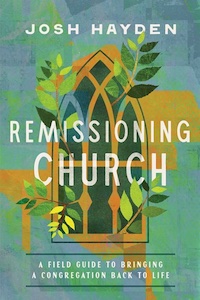Overcoming Inertia by Douglas C. MacLeod Jr.

Remissioning Church
A Field Guide to Bringing a Congregation Back to Life
By Josh Hayden
InterVarsity Press, 2024
$20 248 pp.
Following the death of Pope Francis, before the conclave elevated North American Cardinal Robert Louis Prevost, now Leo XIV, to the papacy, two questions were asked by Catholics and mass media pundits alike: who was going to be chosen and in what direction would Catholicism go in the coming decades. Of course, even with some understanding of Leo XIV’s agenda, the answer to the second question will remain unanswered, being that no one but God knows what the future holds for his flock. However, it is safe to say that changes need to be made to ensure the church is fulfilling its obligation as holy steward of love and peace around the globe.
According to Josh Hayden’s new book, Remissioning Church: A Field Guide to Bringing a Congregation Back to Life, established churches and church leaders are on a journey, both outward and inward, while trying to animate parishioners who are quite comfortable with the status quo. He writes: “The Spirit is inviting established churches into a new future . . . The reality is, the Spirit is waking up established churches to do much more than barely exist—the Spirit is helping them learn how to thrive and make disciples again.” Hayden’s book is meant to be a blueprint toward the “creative destruction,” resurrection, and transformation of what he currently sees as an inert but powerful force in professing the faith.
To do this, Hayden says, church leaders actually need to embrace discomfort and conflict to ensure “remissioning” and revitalization take place. Pastors on this journey of dissent cannot harbor shameful feelings or emotional baggage that weighs down self-growth and hopefulness. Combatant churchgoers need to release themselves “from the idols of power, control, exclusion, and domination so they can taste the sweet freedom that happens through the life, death, and resurrection of Jesus.” Thus, the way forward must be through stewardship, not ownership. There needs to be a plan for the building of a remissioned church that takes place with a sense of timing, attention, and integrity. To be a positive influence in this process, parishioners need to relinquish believing they are the host, become the guest, and allow leaders to lead, especially if they are competent, spiritual, and intentional in their respective agendas about their respective parishes.
Hayden’s argument is that “creative destruction” needs to take place for revitalization to happen. The argument, couched in Hayden’s winning writing style, is persuasive, compelling, and well-constructed. Like Christ, the church needs to rise again as a stronger, holier institution. But resurrection cannot be experienced without death, and a new church will have a hard time surviving without enthusiastic disciples leading the way. Shifting methodologies, mergers, neighborhood rebuilding, and changing demographics are all forms of creative destruction. By adapting to these shifts and changes, the church can be looked at with fresh eyes and fuller hearts.
Much of Remissioning Church is a conversation about these needed changes, but it is also a workbook that provides advice and tools to give church leaders help in what is to be an arduous journey. The book is filled with helpful graphs, questions, and exercises to give pastors what it is they may need to revitalize the church, whether it is to build on and better understand the rituals, practices, and values of Christianity, or to revise their congregants’ thought processes about how race, class, and gender can connect to fundamental church doctrine.
Church leaders have to prune for growth and identify the gaps to transform the church, to keep it thriving and to “transform our brokenness into a place of healing.” Pastors have to foster and embrace remembrance, a theme that Hayden reminds us “runs throughout [the] Scriptures.” Catholics, like all humans, can become forgetful, apathetic, and complacent, and Hayden wants a church community that comes together to figure out how to be more active in mind, body, and spirit so that future generations can be free of vitriol and obstructionism. Transformation has to come out of a concerted effort to make the church more appealing to new parishioners as well as to those who already meet regularly; if not, like most anything else, it could die on the vine.
Remissioning Church is an excellent primer about a problem that needs to be resolved, even if Catholics cannot always recognize the good, the bad, and the ugly surrounding the church. There are moments when the work becomes a bit more like a business plan than a discussion about the self-discovery that leads to fruitful and fluid transformations within the church. Still, all and all, Hayden presents a strategy that will allow for a reimagining, a reset, a restart, and a resurrection of those places devoted to worship and the communal understanding of our faith. ♦
Dr. Douglas C. MacLeod Jr. is an associate professor of composition and communication at SUNY Cobleskill. He has written multiple book chapters, peer-reviewed journal articles, and book reviews throughout his almost 20-year career as an academic and teacher. Recently, he has had essays published in Childhood and Innocence in American Culture: Heartaches and Nightmares (Lexington Books); Holocaust vs. Popular Culture: Interrogating Incompatibility and Universalization (Routledge); and Film as an Expression of Spirituality: The Arts and Faith Top 100 Films (Cambridge Scholars Publishing). He lives in Upstate New York with his wife, Patty.





Leave a Reply
Want to join the discussion?Feel free to contribute!